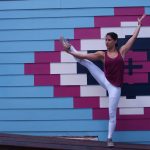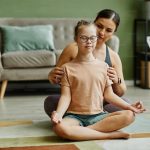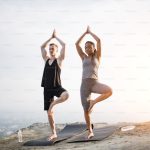Performance anxiety (often called “stage fright”) doesn’t always involve a stage. Anyone whose activity brings them to the attention of an audience, such as a yoga class or (even worse) a yoga assessment, can experience performance anxiety.
What is Performance Anxiety?
Performance anxiety comes about when our energy is occupied by ourselves and our anxiety instead of focusing on the task at hand. Anxiety is a powerful emotion, triggering the release of adrenaline, which prepares the body for danger by readying it for fight or flight. This happens even when the danger is in our mind and not in reality.
If this anxious state is maintained it can give rise to a whole host of physical symptoms: excessive sweating, heart palpitations, dry mouth, clamminess, pins and needles, muscle tension, aches and pains, an inability to concentrate and a sense of impending doom – amongst other things.
It’s not easy doing Revolved Triangle pose at the best of times, but try doing it with just a few of the symptoms listed above – it’s virtually impossible!
See Also: Stress, The Real Deal Or Just An Excuse?
What Causes It?
Doubt, the influence of others and a lack of confidence leaves one in an undetermined state of unsteadiness. Therefore, he/she should be firm in his/her decision.
~ Basic Guidelines for Teachers of Yoga, B.K.S. Iyengar
Going from a yoga student to a yoga teacher is like going from the passenger seat to the driver’s seat. You might think you know how to drive, but when you’re behind the wheel it suddenly goes pear-shaped. The training has prepared you to a certain degree, but when you’re in front of a class, the full weight of responsibility falls squarely on your shoulders leading to a sense of fear and panic. Being at the front of a class puts us in a vulnerable position. We can feel judged, or open to ‘attack’, due to feeling underqualified, or not as good as we should be.
How to Feel the Fear and Do it Anyway
The mistake that a lot of people make is to try to ‘get rid’ of their anxiety. This can have the adverse effect of making us even more anxious. One way to diffuse the sense of stage fright before a yoga class is to both expect (and accept) that you will feel anxious, especially at first. If you allow yourself to work with the anxiety, not against it, you’ll be able to calm down and proceed.
However, it’s also useful to have a few tricks up your sleeve so that you are in control of your anxiety, rather than it being in control of you.
See Also: 3 Ways to Overcome Your Fears and Tackle Greater Ones
1. Play the Part
There’s a reason why a large percentage of yoga teachers have a performance background. It’s scary getting up in front of a class (the audience), and demonstrating yoga poses with a calm and easy grace (performing). It’s also a useful world to draw tips from when tackling the performance anxiety that pretty much every yoga teacher has felt at some point in their career.
When you put on your yoga clothes, imagine that you’re putting on a costume. The costume will help you the play the part of ‘yoga teacher’. Think about the voice and teaching style of a yoga teacher you admire and who you feel exudes confidence and practice teaching in a pose as if you were them – preferably at home in front of the mirror.
Also remind yourself that your students are there to practice yoga, not watch you. They are interested in learning the poses, not criticising the person teaching.
2. Practice Makes Perfect
The best way to avoid the rabbit in the headlights moment is to practice, practice, practice. As you work on your poses in the quiet and safety of your own home, say the instructions out loud to yourself. Practice mirroring by starting on the opposite side to the one you’d usually start on, and then call out the opposite instructions. This is especially worth doing for complicated twists such as Marichyasana III & IV (Marichi’s pose C and D).
Better still, if you’re still at the teacher-training stage, try to organise a practice class made up of willing guinea-pig students and make your mistakes in front of them. Alternatively, speak to your co-students and get together in between training sessions and take turns teaching each other.
3. Get Perspective
Remind yourself of how far you’ve come already. You made a decision to become a yoga teacher, you have applied yourself, worked hard and passed your course. Therefore, you deserve to be in front of this class now. And what you’re feeling is irrelevant to the students in front of you. They need to see the pose, not you. So put your focus onto the determination that has got you all this way already, and use it to channel your attention onto your successes so far, and off your anxiety.
4. And Breathe…
We know that the breath is a powerful tool — we’re students of yoga too, after all! But it’s one thing to ‘know’ it, and another thing to really make use of this knowledge. In order to reduce your day to day stress levels, make time for a pranayama practice as part of your home practice, even if it’s just five minutes in the morning.
If you’re feeling anxious before a class or training day, bring your attention to your breath. Simply become aware of each inhalation and exhalation, without trying to control the flow of the breath. This will allow the body to access a parasympathetic nervous state and reduce the amount of adrenaline being released into your bloodstream, thereby alleviating all those pesky symptoms.
See Also: How Yoga Can Boost Your Nervous System (Part 1)
5. Yoga Your Way from Anxiety to Calm
It’s ironic that yoga teachers should need calming down before yoga teaching. Surely, as yoga teachers, we are already stress and anxiety-free? Nothing can rumple our inner calm. Unfortunately, we’re also human beings and so we too suffer from all the usual anxieties that are felt by everyone else.
The final trick that we can reach for is the reason why we’re up at the front of the class in the first place. Yoga itself. Instead of powering through a hard-core home practice, try an ‘anti-anxiety’ yoga sequence for a week and see if it helps relieve your yoga class anxiety:
- Tadasana (Mountain Pose)
- Uttanasana (Standing Forward Bend)
- Prasarita Padottanasana (Wide-legged Forward Bend)
- Adho Mukha Svanasana — head supported (Downward Dog)
- Sirsasana (Headstand)
- Trikonasana (Triangle Pose)
- Ardha Chandrasanana (Half-Moon Pose)
- Dwi Pada Viparita Dandasana — on a chair, feet to the wall (Legs Up the Wall)
- Ustrasana (Camel Pose)
- Padmasana (Lotus Pose)
- Supta Baddha Konasana (Supine Bound Angle Pose)
- Supta Virasana (Supine Hero Pose)
- Setu Bandha Sarvangasana — feet to the wall (Bridge Pose)
- Viparita Karani (Legs Up the Wall)
- Savasana (Corpse Pose)
See Also: Vinyasa Your Anxiety Away












